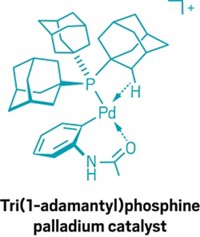Advertisement
Grab your lab coat. Let's get started
Welcome!
Welcome!
Create an account below to get 6 C&EN articles per month, receive newsletters and more - all free.
It seems this is your first time logging in online. Please enter the following information to continue.
As an ACS member you automatically get access to this site. All we need is few more details to create your reading experience.
Not you? Sign in with a different account.
Not you? Sign in with a different account.
ERROR 1
ERROR 1
ERROR 2
ERROR 2
ERROR 2
ERROR 2
ERROR 2
Password and Confirm password must match.
If you have an ACS member number, please enter it here so we can link this account to your membership. (optional)
ERROR 2
ACS values your privacy. By submitting your information, you are gaining access to C&EN and subscribing to our weekly newsletter. We use the information you provide to make your reading experience better, and we will never sell your data to third party members.
Synthesis
Frustrated Lewis Pairs Go Hydrogenating
Lewis acid-base pairs with metal-like reactivity add new facet to synthetic chemistry
by Stephen K. Ritter
December 24, 2012
| A version of this story appeared in
Volume 90, Issue 52
In 2006, Douglas W. Stephan of the University of Toronto and his coworkers took the concept of Lewis acid-base pairs to a new level when they devised a chemical construct known as a frustrated Lewis pair. Lewis acid-base pairs are common in chemistry: An electron-deficient Lewis acid readily shares a Lewis base’s spare electrons. However, when the Lewis acid and base each have bulky substituents, their ability to form a close relationship is denied, and the pair is said to become “frustrated.” The unquenched pair garners penned-up reactivity, comparable to that of an organometallic catalyst. Several research groups have shown that frustrated pairs can trap small molecules such as H2, NO, N2O, SO2, and CO2 and subsequently use them in metal-free reactions to functionalize imines, silyl ethers, and N-heterocyclic compounds. This year, a bevy of new metal-free reactions made possible by frustrated pairs suggest that they are not “a one-trick pony,” Stephan says. Hydrogenations in particular came to the fore. In one example, Stephan and his coworkers tackled aromatic hydrogenations by using B(C6F5)3 as the Lewis acid and various anilines as the Lewis base (C&EN, Feb. 27, page 8; J. Am. Chem. Soc., DOI: 10.1021/ja300228a). The pair splits H2 and then adds the hydrogen to aniline’s aromatic ring, which ultimately leads to cyclohexylamines (shown). This example stands out because hydrogenation of an aromatic compound is hard to accomplish, even with the best transition-metal catalysts. Among other reactions reported this year, Stephan’s group and its collaborators showed that a frustrated pair can hydrogenate polyaromatic hydrocarbons (Chem. Commun., DOI: 10.1039/c2cc37190a) and substituted olefins (C&EN, Sept. 10, page 27; Angew. Chem. Int. Ed., DOI: 10.1002/anie.201204007).







Join the conversation
Contact the reporter
Submit a Letter to the Editor for publication
Engage with us on Twitter